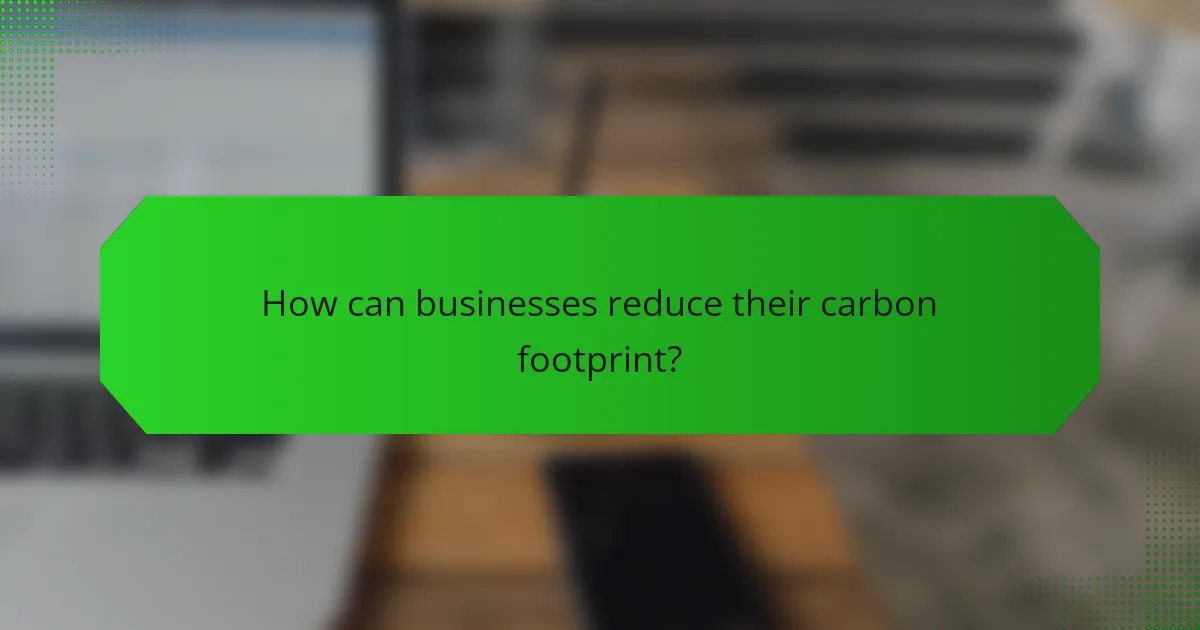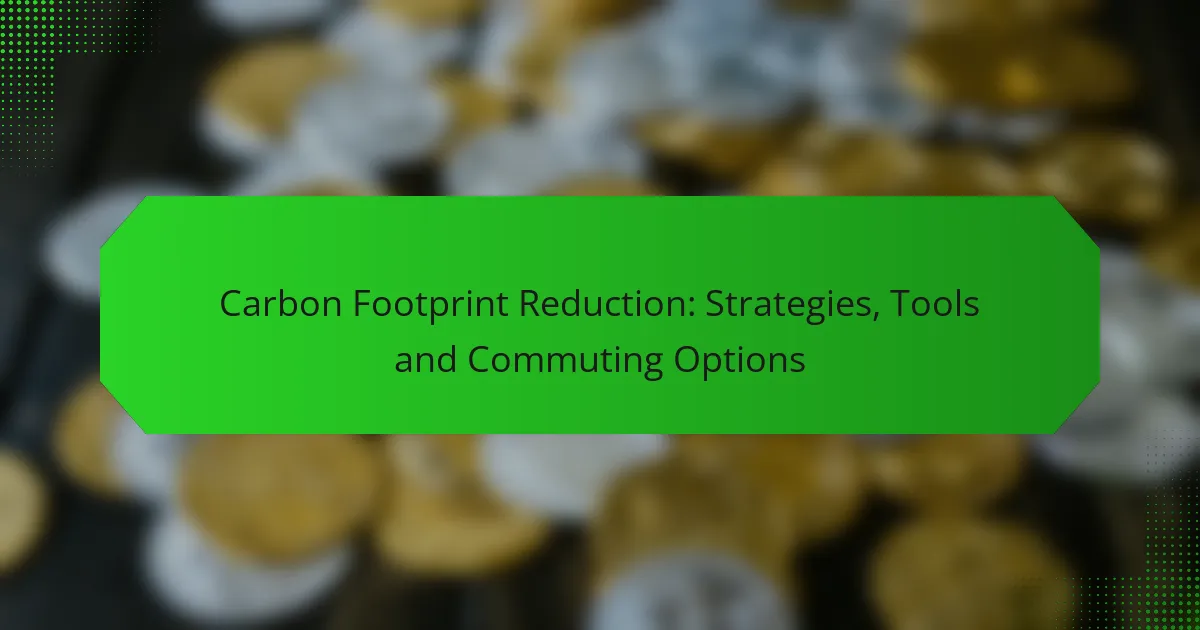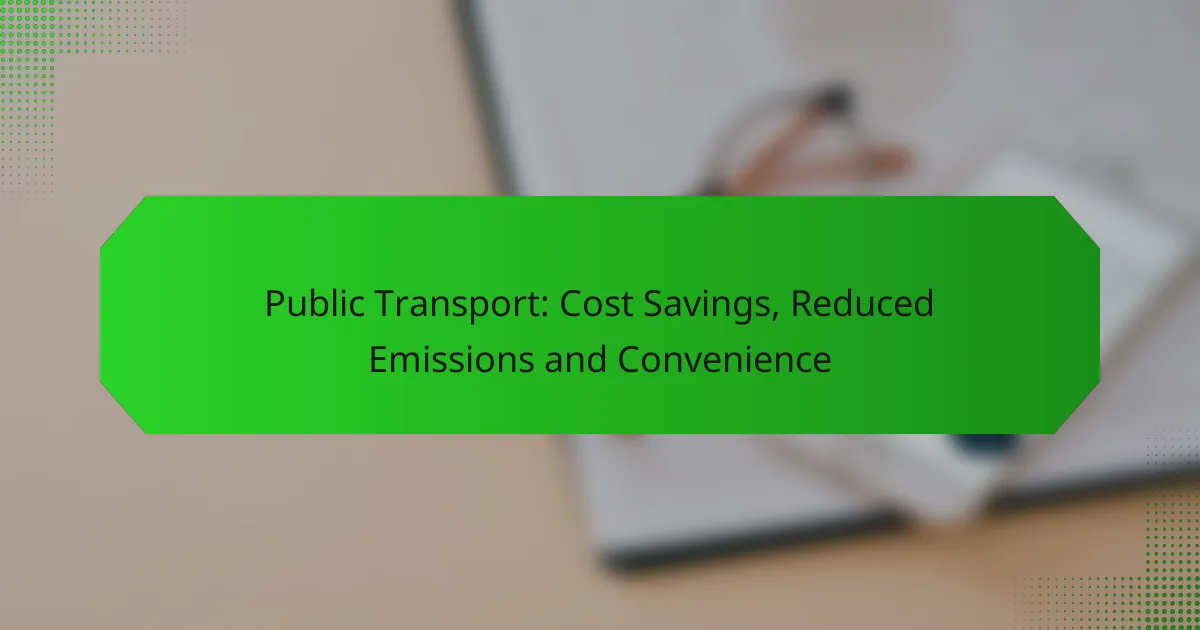Reducing our carbon footprint is essential for combating climate change and promoting sustainability. Effective strategies include improving energy efficiency, adopting renewable energy, and utilizing sustainable transportation options. By embracing these practices, individuals and businesses can significantly lower greenhouse gas emissions while contributing to a healthier planet.

What are the best strategies for carbon footprint reduction?
The best strategies for carbon footprint reduction include improving energy efficiency, adopting renewable energy sources, utilizing sustainable transportation methods, implementing waste reduction techniques, and participating in carbon offset programs. Each of these strategies plays a crucial role in minimizing greenhouse gas emissions and promoting environmental sustainability.
Energy efficiency improvements
Energy efficiency improvements focus on reducing energy consumption while maintaining the same level of service. Upgrading to energy-efficient appliances, enhancing insulation, and using smart thermostats are effective measures. For example, replacing incandescent bulbs with LED lights can cut lighting energy use by up to 75%.
Consider conducting an energy audit to identify areas for improvement in your home or business. Simple actions, like sealing leaks around windows and doors, can lead to significant energy savings and lower utility bills.
Renewable energy adoption
Renewable energy adoption involves transitioning from fossil fuels to sustainable energy sources such as solar, wind, and hydroelectric power. Installing solar panels can significantly reduce reliance on grid electricity and lower carbon emissions. Many regions offer incentives or rebates to offset installation costs.
Evaluate local renewable energy options and consider community solar programs if individual installation isn’t feasible. These programs allow multiple participants to benefit from a shared solar energy system, making it accessible for those who cannot install panels on their property.
Sustainable transportation methods
Sustainable transportation methods reduce carbon emissions associated with travel. Options include walking, cycling, carpooling, and using public transit. For instance, biking instead of driving for short trips can substantially decrease your carbon footprint.
Consider using electric or hybrid vehicles, which produce fewer emissions than traditional gasoline cars. Many cities are expanding charging infrastructure, making it easier to transition to electric vehicles.
Waste reduction techniques
Waste reduction techniques aim to minimize waste generation and promote recycling and composting. Implementing practices such as reducing single-use plastics and opting for reusable products can significantly decrease landfill contributions. For example, using a reusable water bottle instead of plastic bottles can save hundreds of bottles per year.
Encourage composting organic waste to reduce methane emissions from landfills. Many municipalities offer composting programs or resources to help residents start their own compost systems.
Carbon offset programs
Carbon offset programs allow individuals and businesses to compensate for their emissions by investing in projects that reduce or capture greenhouse gases. These projects may include reforestation, renewable energy development, or methane capture from landfills. Purchasing carbon offsets can help neutralize your carbon footprint.
When selecting a carbon offset program, look for certified projects that provide transparency and measurable results. Many organizations offer various options, allowing you to choose projects that align with your values and environmental goals.

How can businesses reduce their carbon footprint?
Businesses can reduce their carbon footprint by implementing sustainable practices, utilizing technology for carbon management, and engaging employees in eco-friendly initiatives. These strategies not only lower emissions but also enhance corporate responsibility and can lead to cost savings.
Implementing green policies
Green policies are essential for businesses aiming to minimize their environmental impact. This can include initiatives such as reducing energy consumption, minimizing waste, and adopting sustainable sourcing practices. For example, companies can switch to renewable energy sources or implement recycling programs to lower their carbon emissions.
Establishing clear guidelines and goals for sustainability can help ensure that all employees are aligned with the company’s environmental objectives. Regularly reviewing and updating these policies is crucial to adapt to new technologies and regulations.
Utilizing carbon management software
Carbon management software helps businesses track and analyze their carbon emissions effectively. These tools can provide insights into energy usage, transportation emissions, and waste production, allowing companies to identify areas for improvement. Many software options also offer benchmarking features to compare performance against industry standards.
When selecting carbon management software, consider factors such as ease of use, integration capabilities with existing systems, and the ability to generate reports for stakeholders. Investing in the right software can streamline the process of reducing emissions and enhance transparency.
Employee engagement in sustainability
Engaging employees in sustainability efforts is vital for the success of any carbon reduction strategy. Businesses can foster a culture of sustainability by providing training, resources, and incentives for eco-friendly practices. For instance, companies might implement carpool programs or offer rewards for employees who use public transportation.
Regular communication about sustainability goals and achievements can motivate employees to participate actively. Creating a dedicated sustainability team or committee can also help drive initiatives and keep sustainability at the forefront of company operations.

What commuting options help reduce carbon emissions?
Commuting options that help reduce carbon emissions include public transportation, carpooling, bicycle-sharing programs, and electric vehicle incentives. Each of these alternatives can significantly lower individual carbon footprints while promoting sustainable travel practices.
Public transportation systems
Public transportation systems, such as buses, trains, and trams, provide an efficient way to reduce carbon emissions by transporting multiple passengers simultaneously. Utilizing these systems can decrease the number of individual vehicles on the road, leading to lower overall emissions.
Many cities offer subsidized fares or monthly passes, making public transport an economical choice. For example, a monthly transit pass can cost significantly less than maintaining a personal vehicle, especially when factoring in fuel and parking expenses.
Carpooling initiatives
Carpooling initiatives encourage individuals to share rides, which can drastically cut down the number of cars on the road. By coordinating with others who have similar routes, commuters can reduce their carbon emissions while saving on fuel costs.
Many organizations and apps facilitate carpooling, helping users find matches easily. Consider joining local carpool groups or using ride-sharing platforms to maximize the benefits of this commuting option.
Bicycle-sharing programs
Bicycle-sharing programs offer a convenient and eco-friendly way to commute short distances. These programs typically provide bikes at various docking stations throughout a city, allowing users to pick up and drop off bikes as needed.
Using a bicycle for commuting not only reduces carbon emissions but also promotes physical health. Many cities have implemented bike lanes and paths to ensure safer travel for cyclists, making this option increasingly accessible.
Electric vehicle incentives
Electric vehicle (EV) incentives encourage the adoption of EVs through tax credits, rebates, and reduced registration fees. These incentives can significantly lower the initial cost of purchasing an electric vehicle, making it a more attractive option for commuters.
In addition to financial incentives, many regions offer perks such as access to carpool lanes and free charging stations. Research local programs to determine available incentives and how they can benefit your commuting choices.

What tools are available for measuring carbon footprints?
Several tools exist for measuring carbon footprints, each designed to help individuals and organizations assess their environmental impact. These tools vary in complexity and focus, catering to different needs from personal tracking to comprehensive assessments.
Carbon footprint calculators
Carbon footprint calculators are user-friendly tools that estimate greenhouse gas emissions based on individual or organizational activities. Users typically input data related to energy consumption, transportation, and waste generation to receive an estimate of their carbon output.
Many calculators are available online for free, such as the EPA’s Carbon Footprint Calculator or the WWF’s Footprint Calculator. These tools can provide insights into specific areas for improvement, helping users identify changes that could significantly reduce their emissions.
Environmental impact assessment tools
Environmental impact assessment (EIA) tools evaluate the potential environmental effects of proposed projects or policies. These tools often follow established guidelines and methodologies, such as those outlined by the International Association for Impact Assessment.
EIAs consider various factors, including air quality, water usage, and biodiversity. They are essential for businesses and governments to ensure compliance with regulations and to minimize negative environmental impacts before project implementation.
Life cycle analysis software
Life cycle analysis (LCA) software provides a comprehensive view of the environmental impacts associated with all stages of a product’s life, from raw material extraction to disposal. This approach helps organizations understand the total carbon footprint of their products and identify opportunities for improvement.
Popular LCA tools include SimaPro and GaBi, which allow users to model different scenarios and assess the impacts of changes in materials or processes. Utilizing LCA can lead to more sustainable product development and informed decision-making regarding resource use.

What are the prerequisites for effective carbon reduction?
Effective carbon reduction requires a clear understanding of your current carbon footprint and a commitment to sustainable practices. This involves assessing energy consumption, transportation methods, and waste management to identify areas for improvement.
Understanding your carbon footprint
To effectively reduce carbon emissions, start by calculating your carbon footprint. This can be done using online calculators that consider factors like energy use, travel habits, and waste production. Understanding your baseline emissions helps prioritize reduction strategies.
Consider tracking your carbon output over time to measure progress. Regular assessments can reveal trends and highlight successful initiatives, enabling you to adjust your strategies as necessary.
Setting realistic reduction goals
Establishing achievable carbon reduction goals is crucial. Aim for specific, measurable targets, such as reducing emissions by a certain percentage within a defined timeframe. For instance, a goal might be to cut carbon emissions by 20% over five years.
Break larger goals into smaller milestones to maintain motivation and ensure progress. For example, start with a 5% reduction in the first year and build from there.
Engaging stakeholders
Involve key stakeholders in your carbon reduction efforts. This includes employees, customers, and suppliers who can contribute ideas and support initiatives. Engaging stakeholders fosters a sense of ownership and accountability.
Consider forming a sustainability committee to oversee carbon reduction strategies and keep everyone informed about progress and challenges. Regular communication can help maintain momentum and encourage participation.
Implementing sustainable practices
Adopt sustainable practices that align with your carbon reduction goals. This may include using energy-efficient appliances, reducing single-use plastics, or encouraging remote work to minimize commuting emissions. Each small change contributes to a larger impact.
Evaluate the effectiveness of these practices regularly. For example, if switching to LED lighting reduces energy consumption significantly, consider expanding similar initiatives to other areas of your operations.



